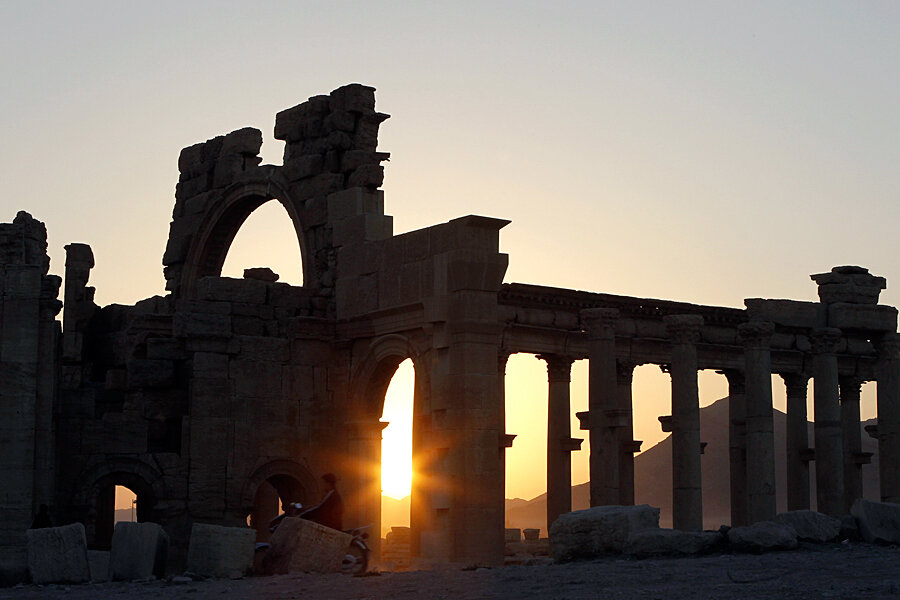Syrian smugglers enjoy a free-for-all among ancient ruins
Loading...
| Reyhanli, Turkey
Syrian rebel Abu Abd al-Tedmuri grew up in the shadow of Palmyra's ancient ruins. Like many in his family, he illegally excavated and sold archaeological treasures on the side. Amid the chaos of war, this business is chugging along.
Sitting on a thin mattress in the apartment in Turkey he shares with a dozen rebel fighters, Mr. Tedmuri quickly swipes through photos on his smartphone, displaying Islamic gold coins and funerary busts – a few of his treasures. He hid some in his hometown, smuggling the rest to Turkey. Most of them he sold.
The artifacts come from Palmyra's majestic Greco-Roman ruins, the remains of a caravan stop between the 1st and 3rd centuries that is recognized by the UN cultural agency, UNESCO, as a world heritage site. Battles between the regime and rebels, many of whom took shelter in the clusters of palm and date trees skirting the ruins, created the perfect opportunity for plunder.
“After the events in Syria, all the ruins became exposed and no one was protecting them,” says the 25-year-old, who worked in an oriental shop in Palmyra before the uprising. “The Army shelled this and other areas on the pretext that rebels were hiding there. The bombing opened up new craters, allowing people easy access to ruins. Some citizens stole ruins seeking a profit, FSA fighters also took stuff to get money for ammunition."
Tedmuri fled, but not before burying the bounty that proved too big to carry and packing away smaller items to sell in Turkey.
'No more fear'
Palmyra and the adjacent town of Tedmur used to be major tourist destinations. Residents made a living off of the hotels, shops, and restaurants catering to visitors, while Bedouins and their camels hawked sunrise and sunset rides among the ruins. The evocative structures are scarred, but they escaped the full-scale destruction wrought on many of Syria's other historic sites and cities.
Still, Tedmuri – whose black market nickname is derived from the town name – has no illusions that tourism will return soon, and is unapologetic about his role chipping away at the national heritage.
Palmyran art, which fuses Greco and Roman techniques with Iranian and indigenous influences, is coveted worldwide. An illicit trade in such artifacts existed well before the conflict, but fear of the mukhabarat, intelligence, kept a check on it. Getting caught could result in a 15-year prison sentence.
The Valley of the Tombs, a necropolis just outside the city’s ancient walls, is one of the main looting sites. Tedmuri says that even the large limestone slabs with human busts representing the interred were sold off on the black market.
"Now there is no more fear," he says.
Booming business
France Desmarais of the Paris-based International Council of Museums (ICOM) says smuggling of cultural objects has “vastly" increased since the start of the conflict, fueled by both professional dealers and amateurs who don't understand the implications. Her organization published the “Emergency Red List of Syrian Cultural Objects at Risk” in 2013 to help civilians and law enforcement officials recognize objects that may be illicitly traded. She warns that many artifacts will only surface years down the line.
Tedmuri considers anything not registered with UNESCO before the war to be fair game. Most of his clients are Turks linked to smuggling mafias or other Syrians working in the business, although one piece was bought directly by a private buyer in Germany. He also makes the occasional trip to Istanbul to sell smaller artifacts to foreign collectors and oriental shop merchants.
Not all of the items in Tedmuri’s collection come from Palmyra. He also has a piece of pottery recovered from Idlib Province, which is rich in ruins. The ceramic vase allegedly dates to the Mari kingdom, a Bronze Age civilization that flourished on the western bank of the Euphrates River. He first put the item up for $500, but in a moment of despair he offered to sell it for $150.
Declining profits
Tedmuri complains that newcomers have driven down prices by flooding the market and ignorantly selling artifacts for less than they are worth. Only half-joking, he says he hopes for a crackdown by the Turkish authorities to drive prices back up.
“Precious pieces are being sold for $300 to $400 a pop – nothing!” he says with genuine indignation. "Veteran smugglers feel sad when they see such items fetching such low prices.”
In a tattered apartment in Reyhanli, three smugglers lay out a sample of their goods. One is an elderly man sporting glasses, the second a wounded rebel seeking a quick commission to cover medical costs, and the third an ex-tourism worker who speaks a smattering of English.
Their stock in Turkey includes ancient ceramic figurines from Talbiseh in Syria, Bronze Age coins, and blackstone oil lamps. They also have a collection of images on their phones of artifacts they say are in Syria but can be brought to Turkey at a moment’s notice for the right price.
They want $3,200 for a trio of an Ancient Greek high-relief silver coin emblazoned with the owl of Athena, a limestone cup, and a metal bird figurine they obtained from another smuggler. A fist-sized Roman head, tagged at $3,500, is their trophy piece.
When pressed, the wounded rebel – a middleman for a bigger player – says he is willing to sell the silver coin for $200.
"He is desperate and doesn’t know the value of what he has,” says the eldest man, exasperated.







